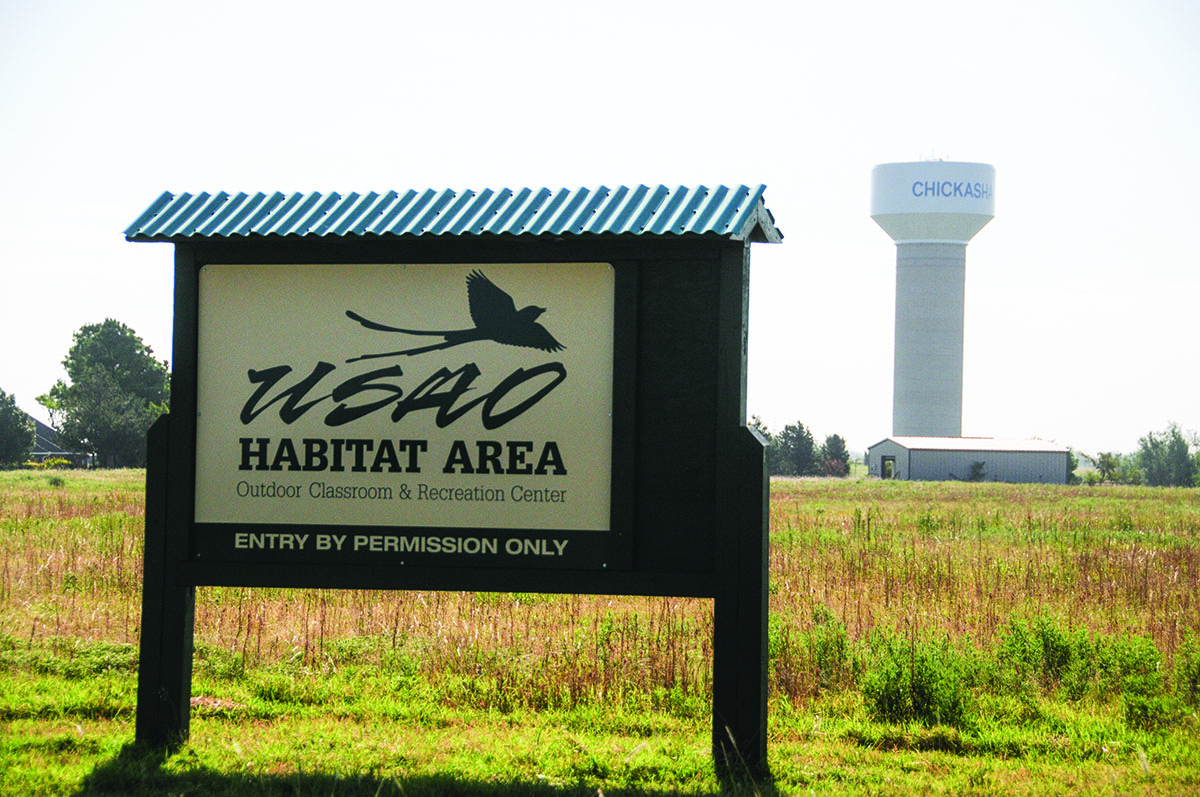Alumni gift, hard work transform habitat
September 10, 2012

New signage marks the entrance to the USAO Habitat Area, which has been recently overhauled
to better serve the campus and community’s educational needs. More information about
public programs using the Habitat can be obtained by calling 574-1313.
It is a place that has been many things to many people.
The Lodge. The Campus Farm. The original site donated for what would become the Oklahoma
College for Women.More recently though, it been transformed by the hard work of a
number of USAO professors, students and organizations along with the generosity of
alumni into something brand new— the USAO Habitat Area.
“I’ve been wanting to do this for 30 years,” said Dr. Darryel Reigh, professor of
chemistry. “But sometimes, you just have to wait for the right combination of factors
to come together in order for something big like this to start moving forward.”
“Now, it has and I couldn’t be more pleased.”For the last 30 years, the 140-acre property,
located a mile or so west of 29th street on Idaho Avenue, has been leased for cattle
grazing.The land was originally deeded over to the university in 1909 by H.C. Cloud
as a future site for the Oklahoma Industrial Institute and College for Girls (OIICG),
though another location was ultimately chosen, according to the USAO Presidential
Archives.
When the most recent grazing lease expired in February, a consensus emerged that it
was time for the property to do more than just generate a small source of revenue
for the university.The resulting plan is ambitious— part reclamation, part transformation
and part imagination.
“Our first priority is to try and re-establish natural grasses on the land," Reigh
said.“Right now, we’ve got a lot of Johnson and Bermuda grasses out here. Through
a variety of means—controlled mowing, selective removal of certain species— we’re
trying to create a space for native grasses like bluestem and Indian switchgrass to
thrive.”
While the feel of the prairie is never too far removed as one walks along the two
trails that wind around the twin ponds, the trees contribute greatly to the sense
of being part of a habitat.Dr. Nancy Osborn, professor of physical education, spearheads
USAO’s Tree Campus USA efforts and has had a hand in bringing new tree life to the
habitat.
“There have been several rounds of plantings,” Osborn said. “We tried to get a good
mix of hard and soft wood trees as well as fruit trees, mostly around the pond areas.”
Staff, faculty and students have been engaged in the tree planting process.In all,
more than 2500 saplings were planted including wild plum, pecan, mulberry, choke cherry,
indian currant, post oak and blackjack oak.
Reigh hopes that the mix of trees will provide wildlife on the property with food
as well as cover. Species observed on the property include deer, turkey, raccoons,
opossum, armadillos as well as a variety of birds like cardinals, scissor-tails, meadowlarks
and blue birds.
Students have already benefitted from this wealth of local fauna by conducting turtle
and mammal surveys in the habitat.
The habitat is not the only feature of the property to receive a face-lift. The lodge,
a one-room building located in the heart of the habitat, is being converted into an
outdoor classroom.In addition to being re-painted and having doors and shutters replaced,
the building was given a new roof through a generous donation from OCLA alumni. A
new concrete patio was poured and small picnic tables were added, creating an attractive
exterior to the outdoor classroom.
Classes have already been held on the property since its rebirth but Reigh says that
they are only the first step.“Eventually, we hope to host public education programs,
especially for grade school students,” Reigh said.
“We’re going to build exhibits in this classroom that show off the plants and animals
that make up this habitat and explain the work that we did to try and return it to
a more natural state.”
Other future plans include wildflower plantings, the development of a marsh area between
the two ponds and organized fishing activities.
With so much to offer campus and community alike, the USAO Habitat Area is poised
to remain an important part of the university’s legacy for years to come.
